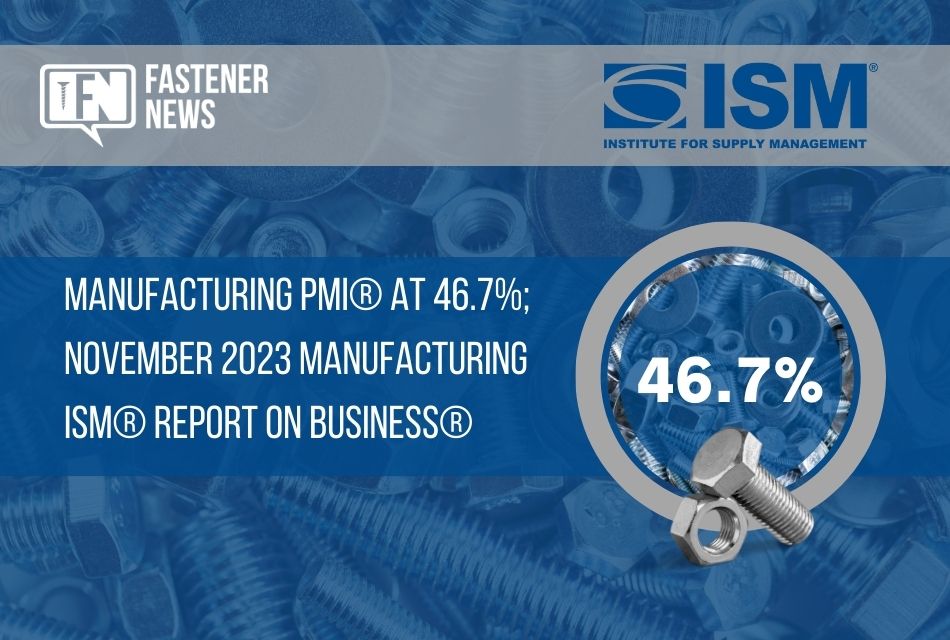Manufacturing PMI® at 46.7%; November 2023 Manufacturing ISM® Report On Business®

New Orders and Backlogs Contracting; Employment and Production Contracting; Supplier Deliveries Faster; Raw Materials Inventories Contracting; Customers’ Inventories Too High; Prices Decreasing; Exports and Imports Contracting
, /PRNewswire/ — Economic activity in the manufacturing sector contracted in November for the 13th consecutive month following a 28-month period of growth, say the nation’s supply executives in the latest Manufacturing ISM® Report On Business®.
The report was issued today by Timothy R. Fiore, CPSM, C.P.M., Chair of the Institute for Supply Management® (ISM®) Manufacturing Business Survey Committee:
“The Manufacturing PMI® registered 46.7 percent in November, unchanged from the 46.7 percent recorded in October. The overall economy continued in contraction for a second month after one month of weak expansion preceded by nine months of contraction and a 30-month period of expansion before that. (A Manufacturing PMI® above 48.7 percent, over a period of time, generally indicates an expansion of the overall economy.) The New Orders Index remained in contraction territory at 48.3 percent, 2.8 percentage points higher than the figure of 45.5 percent recorded in October. The Production Index reading of 48.5 percent is a 1.9-percentage point decrease compared to October’s figure of 50.4 percent. The Prices Index registered 49.9 percent, up 4.8 percentage points compared to the reading of 45.1 percent in October. The Backlog of Orders Index registered 39.3 percent, 2.9 percentage points lower than the October reading of 42.2 percent. The Employment Index registered 45.8 percent, down 1 percentage point from the 46.8 percent reported in October.
“The Supplier Deliveries Index figure of 46.2 percent is 1.5 percentage points lower than the 47.7 percent recorded in October. (Supplier Deliveries is the only ISM® Report On Business® index that is inversed; a reading of above 50 percent indicates slower deliveries, which is typical as the economy improves and customer demand increases.)
“The Inventories Index increased by 1.5 percentage points to 44.8 percent; the October reading was 43.3 percent. The New Export Orders Index reading of 46 percent is 3.4 percentage points lower than October’s figure of 49.4 percent. The Imports Index remained in contraction territory, registering 46.2 percent, 1.7 percentage points lower than the 47.9 percent reported in October.”
Fiore continues, “The U.S. manufacturing sector continued to contract at the same rate in November as compared to October, again posting a reading of 46.7 percent. Companies are still managing outputs appropriately as order softness continues. Demand eased, with the (1) New Orders Index contracting but at a slower rate, (2) New Export Orders Index dropping further into contraction territory, and (3) Backlog of Orders Index dropping below 40 percent (39.3 percent) to remain in strong contraction territory. The Customers’ Inventories Index reading moved into expansion, toward the upper end of ‘about right’ territory, not accommodative for future production. Output/Consumption (measured by the Production and Employment indexes) was negative, with a combined 2.9-percentage point downward impact on the Manufacturing PMI® calculation. Panelists’ companies slightly reduced month-over-month production and took more actions to reduce head counts, primarily using layoffs and attrition. Inputs — defined as supplier deliveries, inventories, prices and imports — continued to accommodate future demand growth. The Supplier Deliveries Index indicated faster deliveries for the 14th straight month, at a faster rate compared to October, and the Inventories Index moved upward while remaining in moderate contraction territory. The Prices Index remained in ‘decreasing’ territory (but just barely), signifying price stability as a result of energy markets easing, though offset by increases in the steel markets. Manufacturing supplier lead times continue to decrease, a positive for future economic activity.
“Of the six biggest manufacturing industries, two — Food, Beverage & Tobacco Products; and Transportation Equipment — registered growth in November.
“Demand remains soft, and production execution is slightly down compared to October as panelists’ companies continue to manage outputs, material inputs and — more aggressively — labor costs. Suppliers continue to have capacity. Sixty-five percent of manufacturing gross domestic product (GDP) contracted in November, down from 75 percent in October. More importantly, the share of sector GDP registering a composite PMI® calculation at or below 45 percent — a good barometer of overall manufacturing weakness — was 54 percent in November, compared to 35 percent in October and 6 percent in September. Three of the top six industries by contribution to manufacturing GDP were at or below 45 percent, same as the previous month,” says Fiore.
The three manufacturing industries that reported growth in November are: Food, Beverage & Tobacco Products; Nonmetallic Mineral Products; and Transportation Equipment. The 14 industries reporting contraction in November — in the following order — are: Paper Products; Printing & Related Support Activities; Electrical Equipment, Appliances & Components; Computer & Electronic Products; Apparel, Leather & Allied Products; Textile Mills; Machinery; Primary Metals; Furniture & Related Products; Miscellaneous Manufacturing; Chemical Products; Fabricated Metal Products; Wood Products; and Plastics & Rubber Products.
WHAT RESPONDENTS ARE SAYING
- “Economy appears to be slowing dramatically. Customer orders are pushing out, and all efforts are being made to right-size inventory levels, both to mitigate carrying costs on pushed-out orders and to load up on inventory where costs are exploding, like cold-rolled steel.” [Computer & Electronic Products]
- “Starting to feel softening in the economy, with labor still a challenge to backfill critical roles. The 2024 forecast looks challenging, specially from a cost perspective.” [Chemical Products]
- “Nearly all microchip supply issues have been resolved, finally bringing an end to the three-year chip shortage. Material prices are remaining relatively flat. Supply chain issues continue in several areas, resulting from difficulties during the United Auto Workers (UAW) strike.” [Transportation Equipment]
- “Our executives have requested that we bring down inventory levels considerably, and it has started causing customer shortages. Both finished goods, and low inventories of raw and packing materials are creating issues in fulfilling customer demand, and in some cases causing serious (production) delays.” [Food, Beverage & Tobacco Products]
- “The end of the major construction season and an early pullback in customer capital expenditures purchases have resulted in a lower backlog in the fourth quarter.” [Machinery]
- “Automotive sales still impacted by UAW strike. Still waiting for orders to come in, and we also need to work down inventory levels that increased during the strike period. This will most likely happen in December.” [Fabricated Metal Products]
- “Customer orders have pushed into the first quarter of 2024, resulting in inflated end-of-year inventory.” [Miscellaneous Manufacturing]
- “(Our situation is) good but guarded, as next year is hard to predict. There are undertones of uncertainty in the market and the impact of inflation on maintenance and project costs has become apparent.” [Nonmetallic Mineral Products]
- “Customers back online after the UAW strike. Consuming inventory that was built as a strike bank. Still (having) issues with hiring quality candidates for both hourly and salaried positions. Current inventory levels are too high, but the order book remains strong.” [Primary Metals]
- “Elevated financing costs have dampened demand for residential investment. Our business has been negatively impacted through reduced new orders for our products and services. We are purchasing less for production and finished goods inventories.” [Wood Products]
About Institute for Supply Management® (ISM®)Institute for Supply Management® (ISM®) is the first and leading not-for-profit professional supply management organization worldwide. Its community of more than 50,000 in more than 100 countries manage about US$1 trillion in corporate and government supply chain procurement annually. Founded in 1915 by practitioners, ISM is committed to advancing the practice of supply management to drive value and competitive advantage for its members, contributing to a prosperous and sustainable world. ISM empowers and leads the profession through the ISM® Report On Business®, its highly-regarded certification and training programs, corporate services, events and assessments. The ISM® Report On Business®, Manufacturing, Services, and Hospital, are three of the most reliable economic indicators available, providing guidance to supply management professionals, economists, analysts, and government and business leaders. For more information, please visit: www.ismworld.org.
The full text version of the Manufacturing ISM® Report On Business® is posted on ISM®‘s website at www.ismrob.org on the first business day* of every month after 10:00 a.m. ET. The one exception is in January, the report is released on the second business day of the month.
The next Manufacturing ISM® Report On Business® featuring December 2023 data will be released at 10:00 a.m. ET on Wednesday, January 3, 2024.
*Unless the New York Stock Exchange is closed.
|
Contact: |
Kristina Cahill |
|
Report On Business® Analyst |
|
|
ISM®, ROB/Research Manager |
|
|
Tempe, Arizona |
|
|
+1 480.455.5910 |
|
|
Email: kcahill@ismworld.org |
SOURCE Institute for Supply Management
RELATED CONTENT:
Manufacturing PMI® at 46.7%; October 2023 Manufacturing ISM® Report On Business®
Manufacturing PMI® at 49%; September 2023 Manufacturing ISM® Report On Business®
Fastener News, Fastener News Desk, Fastener News Podcast, Manufacturing













Leave a Reply